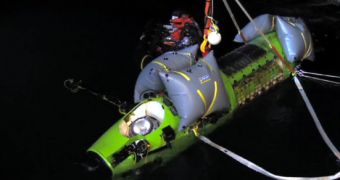Earlier today, the Woods Hole Oceanographic Institution has gone public with the news that explorer and filmmaker James Cameron has agreed to donate his Deepsea Challenger, and that they are to be the beneficiaries of this donation.
For those unaware, James Cameron's Deepsea Challenger is worth about $10 million (€7.71 million), so few can argue against the fact that the filmmaker's decision to donate it is a direct result of his being quite keen on promoting and supporting deep-sea science.
According to the official website for the Woods Hole Oceanographic Institution (WHOI, for short), James Cameron's sub will first and foremost serve as a model for scientists working on developing new technologies meant to allow for a better exploration of marine environments.
“Cameron will transfer the DEEPSEA CHALLENGER to Woods Hole, where WHOI scientists and engineers will work with Cameron and his team to incorporate the sub’s numerous engineering advancements into future research platforms and deep-sea expeditions,” WHOI says.
As previously reported, it was in March 2012 when the Deepsea Challenger took James Cameron all the way to the bottom of the Mariana Trench. Thus, the filmmaker successfully traveled to a depth of 10,900 meters (6.772 miles).
Later on, the submersible was sent to carry out an exploration mission on its own, and succeeded in pinning down outcrops and microbial communities in two different locations at the bottom of the Mariana Trench.
“Our sub is a scientific proof-of-concept, and our partnership with the Woods Hole Oceanographic Institution is a way to provide the technology we developed to the oceanographic community,” James Cameron explained.
Backing up his statements, Susan Avery, the current president and director of WHOI, stated that, “We face many challenges in our relationship with the ocean, so there is heightened urgency to implement innovative approaches. Partnerships such as this one represent a new paradigm and will accelerate the progress of ocean science and technology development.”

 14 DAY TRIAL //
14 DAY TRIAL //